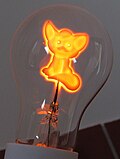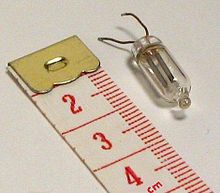Glow lamp
The glow lamp is a gas discharge tube that uses the glow discharge to generate a weak so-called glow light .
The glass bulb of a glow lamp is filled with a gas at low pressure. Usually the noble gas neon is used, which glows with an orange-red color. Two electrodes are embedded in the glass bulb . The glow light is generated at the cathode ; when operating with AC voltage , both electrodes light up alternately. Since glow lamps are usually filled with the noble gas neon, they are classed as neon lamps in this design. There are also glow lamps with other gases, which allow different colors. In English-speaking countries, glow lamps are referred to as neon lamps, even if they are not filled with the noble gas neon .
Applications
Glow lamps are used primarily as signal lamps in various electrical devices, mostly operated with mains voltage , in order to display the operating status. For example, they can be found in electrical household appliances such as irons , coffee machines or in the illuminated power switches of multiple sockets . The glow lamp is also used in technical applications such as the phase tester . The glow lamp is inexpensive to manufacture, but is increasingly being replaced by light emitting diodes (LEDs). Monochrome plasma screens represent a further technical development of the principle .
Another application, not as a lamp but as a kind of switch, is the use as a central element in conventional starters for fluorescent lamps without electronic ballast; also in particularly simple oscillator circuits such as the tilting oscillator for generating vibrations, which was used in early electronic musical instruments . In both cases, the special characteristic of the glow lamp is used functionally.
A special design of glow lamps is the hollow cathode lamp , as it is used for atomic spectroscopy as a reference radiation source.
technology
The distance d between the two electrodes is so small that at U ≈ 100 V the field strength U / d is sufficient to cause spontaneous impact ionization , which after an avalanche effect converts the gas mixture contained at least partially into the necessary plasma .
In the case of commercially available neon-filled glass bulbs with iron electrodes and a gas pressure of 1 mbar, the result is an ignition voltage of around 100 V (point A ). The specific voltage depends, among other things, on the gas pressure, the electrode material and the type of gas filling. Ignition is made easier by adding 0.5% argon .
The incipient glow discharge causes a current to flow and the voltage across the lamp to drop. If the holding voltage B is undershot when the current is too low , the lamp goes out. The negative characteristic curve between points A and B is the result of the so-called cathode fall and represents a negative differential resistance that can be used to generate a breakover oscillation .
If the internal resistance of the supply voltage source is correspondingly low, there is a sharp increase in current after ignition, whereby the glow discharge changes into an arc discharge - characterized by a high arc temperature - and thus leads to thermal destruction of the lamp. For this reason, glow lamps must always during operation of power source with a protective resistor are provided for limiting the current which is dimensioned so that the operating point in the characteristic curve between the points B and C is.
In addition to the neon gas filling with orange-red color, other colors can also be achieved by using other filling gases, for example white with krypton and blue-green with argon . See also the colors of fluorescent tubes .
If a current of around 1 mA flows through a glow lamp in an illuminated switch (light switch, socket strip, etc.), this results in an energy requirement of around 2 kWh per year in continuous operation .
Light output
The luminous efficacy of glow lamps is considerably higher than that of incandescent lamps ; depending on the design and color, it is up to 65 lm / W. Most of the glow lamps used today have a power consumption of less than 4 W so that no energy efficiency class has to be specified. The efficiency class C is specified for glow lamps with a power consumption of more than 4 W.
lifespan
The lifespan of glow lamps is given as 5000 to 100,000 hours.
history
Large glow lamps were used for lighting purposes in buildings during the existing darkening obligation, for example, in the Second World War . Its electrodes consisted of a type 1 double helix that tapered towards the top and was fused into a common, general-purpose lamp glass bulb with an E27 Edison base . The series resistor was located in the base. The shape of the electrodes gave it the name beehive glow lamp . Their power was between two and four watts including series resistor. They were manufactured until the 1980s and can still be found in individual schools physics collections.
At the end of the 1930s, experiments were also carried out with the glow lamp as a rectifier . The rectifier effect is based on an asymmetrical shaping of the two discharge electrodes or on electrode coatings to reduce the cathode drop. The glow rectifier was not able to establish itself in practice because of its very poor ratio of forward to reverse current (<100: 1).
In the 1950s, using the negative differential resistance with the help of small glow lamps, various oscillator circuits were developed and used in combination with counting circuits and frequency dividers in the first electronic organs emerging at that time . Other applications were simple circuits as ignition generators in stroboscopic lamps .
In measuring and laboratory devices equipped with tubes, glow lamps were also used as voltage stabilizers in the range from about 80 to 500 V. These glow stabilizers are connected as shunt regulators and in some cases contain several discharge paths.
A special design with candle-like electrodes is known as a flicker candle . Further applications were digit display tubes - the so-called Nixie tubes - , counter tubes , voting and matrix displays . In these areas, glow lamps have been almost completely replaced by other technologies such as light-emitting diodes or vacuum fluorescent displays .
Designs
| example | description |
|---|---|

|
Socket-less glow lamps with rod-shaped electrodes and various types of gas fillings. |

|
Neon-filled, socketless glow lamp with rod-shaped electrodes, diameter approx. 8 millimeters; the electrodes light up alternately per half cycle, as the two snapshots show; Spectrum: red and yellow neon lines as well as the faint green spectral line at 540 nanometers. |

|
Glow lamp with E10 base . The upper and lower electrodes form a luminous disc when viewed from the luminous side (in the picture above). |

|
Socketed glow lamps for operating voltages up to 230 V with a series resistor in the base and a phase tester with socketless glow lamp for voltage display . |

|
Flicker candle with E14 base. The electrode is flame-shaped with a large surface and consists of partially oxidized, uncleaned iron sheet, which results in a candle-like flickering effect. |

|
Glow lamp with E27 base and artistically designed electrode. |

|
The glow lamps also include the Nixie tubes , the cathodes of which are shaped in the form of numbers or other symbols. They were mainly used in older digital measuring devices and operated with DC voltage. |

|
Matrix display of a plasma display from a pinball machine . By changing the voltage of individual pixels , gray levels can be displayed. |
literature
- Karl Küpfmüller , Wolfgang Mathis , Albrecht Reibiger: Theoretical electrical engineering. An introduction . 18th edition. Springer, Berlin 2008, ISBN 978-3-540-78589-7 ( limited preview in the Google book search).
Individual evidence
- ↑ Glow lamp elements / service life. In: FAQ. Gira, Giersiepen GmbH & Co. KG, accessed on December 20, 2014 .
- ↑ Osram GmbH KG (ed.): OSRAM glow lamps . Price list G. September 1952 ( patric-sokoll.de [PDF; 3.7 MB ; accessed on November 18, 2019]).
- ↑ Nentwig, Geffcken, Richter: The glow tube in technology. German Literary Institute J. Schneider, Berlin-Tempelhof 1939, p. 110 ff.
- ↑ AA Vuylsteke: Neon lamp flip-flop and binary counter. In: Electronics, Vol. 26, p. 248 (April 1953).
- ^ MS Raphael, AS Robinson: Digital storage using neon tubes. In: Electronics, Vol. 29, pp. 162-165 (July 1956).
- ^ JC Manley, EF Buckley: Neon diode ring counter. In: Electronics, Vol. 23, pp. 84-87 (January 1950).
- ↑ CE Hendrix, RB Purcell: Neon lamp logic gates play tic-tac-toe. In: Electronics, Vol. 31, pp. 68-69 (June 20, 1958).



